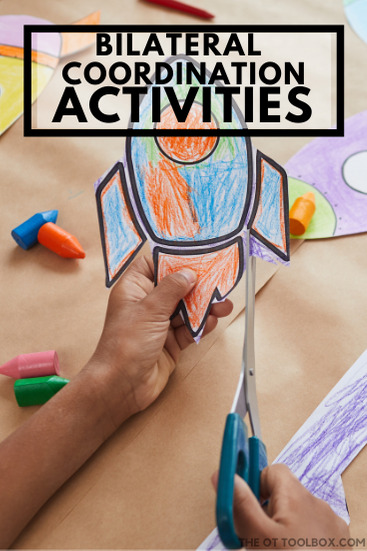
Bilateral coordination activities are essential for coordinated and fluid movements that require both sides of the body. Also called bilateral integration, the movements of both hands together in activities requires processing and integration of both hemispheres of the brain to enable both hands working together at the same time, or bilateral movements. Without bilateral coordination, a child might appear to be clumsy or drop items, use primarily one hand in activities, or switch hands during tasks that require a dominant hand and a helper hand. Development of bilateral coordination skills is powerful in functional skills like self-feeding, handwriting, self-dressing, grooming, and more.

First, let’s talk a little more about bilateral coordination. What is bilateral coordination, and how do bilateral movements impact learning, functional tasks, and play in child development?
Activities that support development of bilateral coordination skills integrate several areas of development:
Each of the areas listed above are both needed for participation in tasks requiring bilateral skills and developed, or strengthened through participation. Play is a powerful tool to support these areas.
Check out these bilateral coordination toys to help kids build skills through play and games.
When bilateral coordination or bilateral integration is intact and progressing appropriately through development, it is an indicator that both sides of the brain are communicating effectively and sharing information during functional tasks.
Younger toddlers and babies can be observed using both hands in play as they pick up objects in their line of sight. However, they typically will pick up items with the hand that is closest to the object or toy.
As toddlers progress in development, they will begin to establish a dominant hand and crossing midline. Read more about this in our resource on cross crawl exercises.
This ability to utilize a dominant hand and a non-dominant hand in activities indicates a maturation of the brain and lateralization in functional tasks, which is very important for motor planning, directionality, and visual motor skills.
When a child is challenged in development of bilateral coordination skills, there can be resulting difficulties.
In fact, impaired bilateral coordination skills can lead to difficulty in the classroom. Science tells us that problems with bilateral coordination can have an impact on academic performance, with slowness and disinterest in schoolwork.
In the school setting there are many areas that can be a challenge as a result of bilateral coordination struggles:
Development of bilateral coordination in self-feeding depends greatly on the child’s developmental level. The baby who is learning to place dry cereal in their mouth will be vastly different level than the child who is scooping soup or cutting a piece of chicken. Development of fine motor skills and visual motor skills have an impact on coordination of the hands in self-feeding.

There are three different types of bilateral coordination. Let’s break these down.
1.) Symmetrical movements– Both hands do the same thing at the same time. An example of this would be pulling up pants or socks. Other activities that can work on this skill include
2.) Alternating Movements– Using the two extremities in alternating motions. You will see alternating bilateral coordination with swimming or climbing a ladder. Activities to work on this skill include:
3.) Dominant hand/Non-dominant hand– Using one hand to perform a task while the other assists is needed for many fine motor skills. This type of bilateral coordination is needed for writing, and cutting with scissors. Activities to work on this skill include:
This occupational therapy tool is Easter-themed but it builds the skills needed for kids to cut with scissors while refining and building accuracy with scissor skills.
Bilateral coordination is closely related to the vestibular system. When our body registers movement and gravity it allows us to respond with appropriate movement, balance, and posture. The vestibular system and our body’s ability to register information and integrate it into movements enables bilateral coordination and body awareness of the upper and lower body. Below, you will find all of our activities that build and develop bilateral coordination. Try these activities to work on many skills like visual motor integration and fine motor skills while encouraging bilateral coordination. Be sure to stop back, because this page will be updated often!
Related: Need some indoor bilateral coordination activities like this one? Try our list of Winter Bilateral Coordination Activities that kids will love!
Occupational therapy practitioners target underlying skills like bilateral coordination because these skills impact function. OTs will work on bilateral coordination goals in occupational therapy with a focus on function. This means that a daily functional task like getting dressed requires bilateral coordination in order to pull up ones pants and put on a shirt. OTs and OTAs don’t just have a goal for bilateral coordination because their client or patient can’t put on their clothing. They focus the goal around getting dressed with a focus on bilateral coordination skills which are used in the task.
We’ve discussed above, that bilateral coordination refers to the ability to use both sides of the body together in a coordinated and controlled manner. When it comes to ADLs and IADLs, you can see how bilateral coordination is used all day long! Occupational therapy goals related to bilateral coordination are often tailored to improve a person’s ability to perform various functional tasks.
Occupational therapy bilateral coordination goals target skills such as:
Here are some examples of bilateral coordination goals in occupational therapy:
These goals can be tailored to the individual’s specific needs and abilities, taking into account factors such as age, developmental level, and underlying conditions. It’s essential for occupational therapists to select goals that are functional and meaningful to the client’s everyday life, promoting independence and participation in desired activities.
We’ve included many bilateral coordination activities that are founded through play.